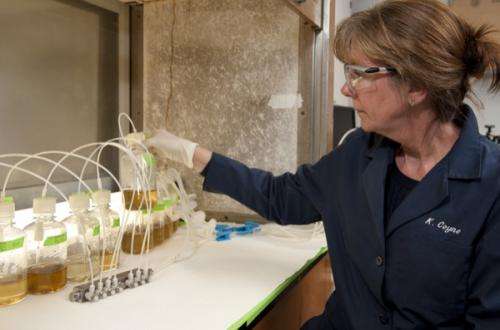Pollution-fighting algae: Algae species holds potential for dual role as pollution reducer, biofuel source

(Phys.org) —A hardy algae species is showing promise in both reducing power plant pollution and making biofuel, based on new research at the University of Delaware.
The microscopic algae Heterosigma akashiwo grows rapidly on a gas mixture that has the same carbon dioxide and nitric oxide content as emissions released from a power plant.
"The algae thrive on the gas," said Kathryn Coyne, associate professor of marine biosciences in UD's College of Earth, Ocean, and Environment. "They grow twice as fast and the cells are much larger in size compared to when growing without gas treatment."
The algae also make large amounts of carbohydrates, which can be converted into bioethanol to fuel vehicles. The findings could have industrial applications as a cost-effective way to cut greenhouse gas pollution when paired with biofuel production.
Heterosigma akashiwo is found worldwide in the natural environment. Coyne, an expert in algal blooms, discovered that the species may have a special ability to neutralize nitric oxide—a harmful gas that poses threats to environmental and human health.
That characteristic prompted Coyne and her team to investigate whether the algae could grow on carbon dioxide without getting killed off by the high nitric oxide content in power plants' flue gas, which had foiled similar attempts by other scientists using different types of algae.
A yearlong laboratory experiment shows that Heterosigma akashiwo not only tolerates flue gas, but flourishes in its presence. The algae also do not need any additional nitrogen sources beyond nitric oxide to grow, which could reduce costs for raising algae for biofuel production.
"This alone could save up to 45 percent of the required energy input to grow algae for biofuels," Coyne said.
Funded by the Delaware Sea Grant College Program, Coyne and her collaborator, Jennifer Stewart, plan to further study how changes in conditions can enhance the growth of Heterosigma akashiwo. So far, they found a large increase in carbohydrates when grown on flue gas compared to air. They also see correlations between the levels of light given to the algae and the quantity of carbohydrates and lipids present in the organisms.
The researchers are exploring opportunities for partnerships with companies to scale up the growth process and more closely examine Heterosigma akashiwo as a biofuel producer.
The prospects could support a national focus on carbon pollution reduction following President Barack Obama's major speech this week on climate change.
"Our approach to the issue is to not just produce biofuels, but to also use this species for bioremediation of industrial flue gas to reduce harmful effects even further," Coyne said.
More information: www.deseagrant.org/research/development/SCD-2
Provided by University of Delaware

















